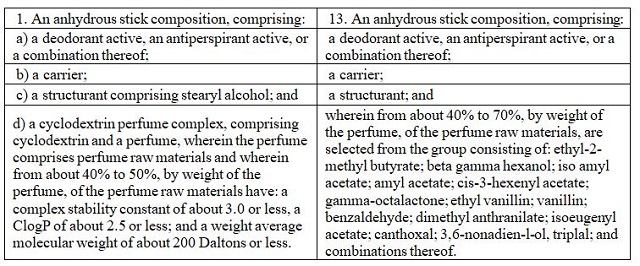The PTAB in Ex parte Sturgis (Appeal 2021-002857; USSN 15/696,282) reversed an examiner's obviousness rejection of claims for failing to sufficiently establish obviousness via routine optimization The reversal was mainly based upon plural selections being claimed without any particular directions on choosing in the prior art and an unpredicted effect based on the cited art.
The claims in question related to a deodorant / antiperspirant composition recited in two independent claims as indicated below.

The prior art cited against the claims was the applicant's own prior work, Scavone, and a secondary reference. The rejection relied upon the Scavone's disclosure that one or more fragrance can be complexed to cyclodextrin, in describing that "[a] representative, non-limiting, list of fragrance materials that may be complexed with the cyclodextrin includes ... and mixtures thereof." The examiner characterized Scavone as describing "greater than about 75%," the percent of fragrance complexed with cyclodextrin, and that there was overlap with some of the claimed fragrances.
Scavone actually described that "[i]n accordance with at least some of the preferred embodiments, the percent of fragrance material that is complexed with cyclodextrin is greater than about 75%, in some instances greater than about 90%, and in other instances greater than about 95%." Scavone also described that
[0044] [a] representative, non-limiting, list of fragrance materials that may be complexed with the cyclodextrin includes anethole, benzaldehyde, decyl aldehyde, benzyl acetate, benzyl alcohol, benzyl formate, benzyl propionate, iso-bornyl acetate, camphene, cis-citral (neral), citronellal, citronellol, citronellyl acetate, paracymene, decanal, dihydrolinalool, dihydromyrcenol, methyl benzyl carbinyl acetate, dimethyl benzyl carbinyl acetate, dimethyl phenyl carbinol, eucalyptol, helional, geranial, geraniol, geranyl acetate, geranyl nitrile, cis-3-hexenyl acetate, dihydrocitronellal, d-limonene, linalool, linalool oxide, tetra-hydro linalool, alpha-methyl ionone, methyl nonyl acetaldehyde, methyl phenyl carbinyl acetate, laevo-menthyl acetate, menthone, iso-menthone, myrcene, myrcenyl acetate, myrcenol, nerol, neryl acetate, nonyl acetate, phenyl ethyl alcohol, phenyl acetaldehyde, alpha-pinene, beta-pinene, gamma-terpinene, terpineol, alpha-terpineol, beta-terpineol, terpinyl acetate, vertenex (para-tertiary-butyl cyclohexyl acetate), gamma-methyl ionone, undecalactone, undecylenic aldehyde, alpha-damascone, beta-damascone, amyl acetate, lemon oil, orange oil, and mixtures thereof.
[0045] Additional fragrant or odor controlling materials suitable for use in embodiments of the present invention include, but are not limited to, hexyl cinnamic aldehyde, alpha-amylcinnamic aldehyde, p-anisaldehyde, cinnamic aldehyde, cuminic aldehyde, p-t-butyl-alpha-methyldihydrocinnamaldehyde, 4-hydroxy-3-methoxycinnamaldehyde, 2-phenyl-3-(2-furyl)prop-2-enal, vanillin isobutyrate, ethyl vanillin acetate, vanillin acetate, cyclamen aldehyde, heptanal, lauryl aldehyde, nonanal, octanal, phenyl propyl aldehyde, vanillin, salycil aldehyde, cytral, 2,4-dihydroxy-3-methylbenzaldehyde, 2-hydroxy-4-methylbenzaldehyde, 5-methyl salicylic aldehydes, 4-nitrobenzaldehyde, o-nitrobenzaldehyde, 5-ethyl-2-thiophenecarbaldehyde, 5-methyl-2-thiophenecarboxaldehyde, 2-thiophenecarbaldehyde, asaronaldehyde, 5-(hydroxymethyl)-2-furaldehyde, 2-benzofurancarboxaldehyde, 2-benzofurancarboxaldehyde, 4-ethoxy-3-methoxy benzaldehyde, [p]rotocatechualdehyde, [h]eliotropine, 2,3,4-trimethoxybenzaldehyde, 3,4,5-trimethoxybenzaldehyde, 2,8-dithianon-4-3n-4-carboxaldehyde, [s]orbinaldehyde, 2,4-heptadienal, 2,4-decadienal, 2,4-nonadienal, (E,E)-,2,4-octadien-1-al, 2,4-octadienal, 2,4-dodecadienal, 4-undecadienal, 2,4-tridecadien-1-al, 2-trans-4-cis-7-cis-tridecatrienal, piperonylidenepropionaldehyde, 2-methyl-3-(2-furyl)acrolein, 2,4-pentadienal, 2-furfurylidene butyraldehyde, 3-(2-furyl)acrolein, Pyruvaldehyde, Ethanedial, menthol, 3-buten-2-one, 3-methyl-4-(2,6,6-trimethyl-2-cyclohexen-1-yl), 4-(2,6,6-trimethylcyclohen-1-en-1-yl)but-3-en-2-one, 3-buten-2-one,4-(2,6,6-trimethyl-2-cyclohexen-1-yl)-, (E)-, menthyl lactate, isomenthyl acetate, isomenthyl propionate, isomenthyl isobutyrate, camphor, p-menthane, cresol, tetrahydromyrcenol, cytronellol [sic], cytronellyil [sic] derivatives, geranyl derivatives, linalyl acetate, mugetanol, eugenol, jasmal, pinanol, cedrene, beta pinene, cineole, nonadienol, ethylhexanal, octanol acetate, methyl furfural, terpinene, thujene, amylacetate, benzylacetate, di-hydrocumarin, di-hydromyrcenyl acetate, [i]soamylacetate, para-cymene, triethyl acetate, para-cresol, ethyl acetate, benzyl-benzoate, isopropyl myristate, methyl abietate, [e]thanol, [i]sopropanol, diethyl sebacate, [g]lycerol, propylene glycol, 1,2-butylene glycol, dipropylene glycol, 2-methyl-2,4-pentanediol, diethylene glycol monoethyl ether, diethyl phthalate, hexyl salycilate [sic], triethyl citrate, benzyl salicylate, and mixtures thereof.
That is, Scavone described a relatively long list of options, not including the majority (9 of 13) of the compounds from claim 13. Of the compounds recited in claim 13, Scavone disclosed ethyl vanillin, vanillin, benzaldehyde, dimethyl anthranilate, and 3,6-nonadien-l-ol ("nonadienol"). Not disclosed were ethyl-2-methyl butyrate, beta gamma hexanol, isoamyl acetate, amyl acetate, cis-3-hexenyl acetate, gamma-octalactone, isoeugenyl acetate, canthoxal, and triplal.
The applicant argued that Scavone failed to teach any particular reason to select certain perfume raw materials, failed to teach anything about the specific structure or parameters of individual perfume raw materials, and failed to designate a typical, preferred, or optimum species of perfume raw materials. The applicant also argued that Scavone failed to discuss the properties of perfume raw materials and that there was no established predictability of the technology, noting that Scavone did not identify, disclose, or discuss the advantageous properties of perfume raw materials based on their complex stability constant, ClogP, and weight average molecular weight, and their ability to be released from an anhydrous antiperspirant or deodorant stick when complexed with cyclodextrin.
The PTAB acknowledged that Scavone's ¶ [0024] did teach the amount of perfume in the cyclodextrin perfume complex "can vary greatly depending on the manufacturing techniques employed," and that Scavone indicated the percent of fragrance material associated with the interior of a cyclodextrin complex (as opposed to being on the exterior region, i.e., a selection) is results effective. However, in the PTAB's view, Scavone did not disclose that where more than one fragrance is complexed with cyclodextrin, differences in concentration of certain fragrance materials in that complex provide for difference in result of the product. That is, the PTAB took the position that the effect of combining the selected elements – particularly scent molecules with the cyclodextrin, in the particular amounts – in the applicant's claim was unpredictable. Citing to In re Stepan Co., 868 F.3d 1342 (Fed. Cir. 2017) the PTAB restated that "a conclusion of obviousness cannot stand where there is a failure to provide an appropriately supported explanation why it would have been routine optimization to select and adjust particular percentages of a claim element."
The reversal in Ex parte Sturgis is a reminder that a rejection based mainly on the mere existence of a set of choices in the prior art, even where a portion (but not all) of the choices are known to be result effective, can be insufficient for a finding of obviousness in unpredictable arts.
The content of this article is intended to provide a general guide to the subject matter. Specialist advice should be sought about your specific circumstances.


